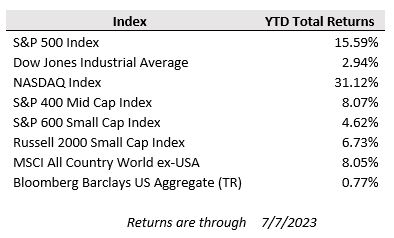Despite a weaker than anticipated June jobs report on Friday, a series of strong economic data releases last week increased the likelihood of further rate hikes from the Federal Reserve, which weighed on stock and bond markets. Bond yields are now pushing back to levels not seen since early March before the collapse of Silicon Valley Bank. The 10 year-U.S. Treasury yield notched its largest weekly gain since May and crossed back above 4% while the 2-year briefly eclipsed 5% before closing the week at 4.94%. Meanwhile, the S&P 500 fell by 1.2% for the week and the Dow Jones and Nasdaq Composite also recorded losses of 2% and 0.9%.
Last week’s jobs data sent some mixed signals on the U.S. labor market as Friday’s June employment report from the Bureau of Labor Statistics announced a nonfarm payrolls increase of just 209k, which came in much softer than a blockbuster report from ADP on Thursday showing a 497k jobs gain. Additionally, the BLS release showed even further moderation in job growth as the last two months of payroll increases were revised down by 110k. However, the 3-month average of job growth stands at a still strong 244k, despite the revision. Meanwhile, the unemployment rate ticked down from 3.7% to 3.6% and wage gains remained higher than expected, up 4.4% year-over-year. The bottom line of these reports is that job growth is indeed cooling, especially in manufacturing and retail industries, but remains quite strong overall. This is a desirable outcome for markets as it shows incremental progress towards the Federal Reserve’s goal of reining in an overheating labor market while jobs growth and wage gains remain resilient to support consumer spending.
While the labor data is a step in the right direction, there is more work to be done before the Fed can take its foot off the brakes to bring down inflation. The Institute for Supply Management reported last week that its index of U.S. service sector activity inflected strongly higher in June, rising to 53.9 from 50.3 in May (any reading above 50 indicates expansion). Service sector activity has been gradually decelerating over the past year, but the June report reversed this trend and contributes to the picture of sustained economic strength.
Market participants will get another important update on the state of inflation in the week ahead with the consumer and producer price indices both on the docket. Both indices are expected to show continued cooling price pressures in June with consensus economist year-over-year forecasts of 3.1% and 0.4% for CPI and PPI, respectively, compared to 4.0% and 1.1% in May.
Second quarter corporate earnings season will also kick-off this week with several of the major financial institutions like JP Morgan and Citigroup set to report earnings as well as PepsiCo and Delta Air Lines. According to FactSet, the S&P 500 is expected to record a third consecutive quarter of declining earnings with the aggregate consensus net income forecasts of all the index constituents expected to be down 7.2% compared to a year ago. A low bar may set up companies well for beating expectations, but investors will also be closely listening to forward guidance and how well companies can continue to protect profit margins by passing on elevated input costs to consumers whose excess stimulus savings are winding down.


